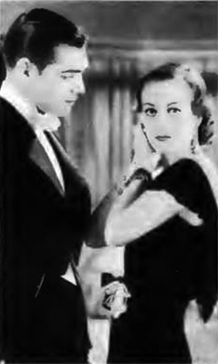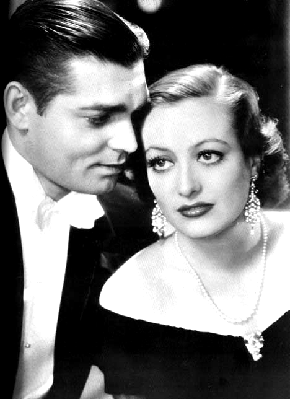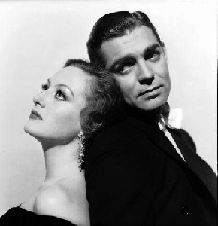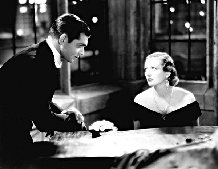

Female fans of Clark Gable complained that Joan Crawford got the better camera treatment in 1931's Possessed. This photo appeared in the February, 1932 issue of
Photoplay magazine, copyright expired.
2013 TCM "Summer Under The Stars" Blogathon
Hosted by: Sittin On A Backyard Fence http://sittinonabackyardfence.com/ and Scribehard on Films http://scribehardonfilm.wordpress.com/
Possessed, shown on TCM Sunday, August 25, 6:45 a.m. CST
Posted by Mary McCord, Editor, classicfilmwatch.com
I had never seen Possessed (1931) with Joan Crawford and Clark Gable before this blog project and I wanted to see and write about a movie that would be new to me. So many of the classics, I have seen many times and they are as familiar as my keyboard. There were three reasons I chose this movie in particular to write about.
ONE: Lately, I’ve been exploring more and more movies made during the early 30s, the pre-code era. Possessed was considered to be very risqué when it was first released because it was about a young woman who became the mistress of a wealthy New York attorney. It was advertised "for those who like their film fare hot and the morals of their screen heroines loose." This is intriguing enough for me to want to see how this subject matter would have been handled in 1931. The reason I am interested in pre-code films is that I have discovered, after many, many years of watching classic movies from the 40s, that films from this era often portray women in unusual roles that depict them as being incredibly strong. I also like the surprising subjects that are examined and the endings that are often unpredictable, sometimes ignoring society’s expectations of what would be a just ending. And, on this score, I wasn’t disappointed with Possessed.
TWO: I am intrigued by the fact that the young Joan Crawford promoted herself early in her career as a 20s flapper-about-town, winning Charleston contests and literally making things happen for her career. I have always associated Crawford with her later movies when she was older and a seasoned actress. I wanted to see her as beautiful and young, playing a woman who was as determined to get ahead as Crawford was determined to advance her career in real life. Again, I wasn’t disappointed.
THREE: I was really happy to see that TCM chose to highlight Clark Gable during their “Summer Under The Stars” event because he is one of my favorite actors. It is never disappointing to see him on the screen. I like his rugged good looks and the characters he plays. The local lore in the rural area where I grew up in Alabama is that Clark Gable used to drive through, stopping at a small cafe for a bite to eat, on his way to Florida. I guess he liked greasy, Southern food because he stopped more than once during the 20s and 30s before interstates existed. I always liked this story. It makes me think of him as a regular guy, eating bar-b-que or the blue plate special in a simple cafe.
After Gable's movie career progressed, he probably appreciated the small town eatery where the other diners were more than likely local merchants, farmers and cotton mill employees who may not have known he was an actor. Even if he was recognized, the practical, down-to-earth locals may not have paid him that much attention. The men may have even been of the opinion that Gable wasn’t much different from them, thinking some 1930s variation of “he puts his pants on one leg at a time, too.” And Clark Gable would have understood the attitude. He, like Joan Crawford, came from humble beginnings. As a youth, he worked on a family farm in Ohio. When he left home, he worked at various menial jobs, including a stint at a lumber mill.
While the men may have ignored him in the cafe, you can be certain that the young waitress and the women diners wouldn’t have missed a thing. Gable received a lot of attention, mostly female with his last picture of 1931, Possessed. He was so popular that his fans wrote to Photoplay magazine in February, 1932, complaining about how Joan Crawford got the better shots in the film, more full-faces and close-ups. “Practically all we saw of our favorite actor was the back of his handsome head and neck,” one fan wrote. (See the letters excerpt from the magazine at the right.)
Possessed was the third film for Gable where he had a significant role. His first starring role was in Sporting Life. He followed this picture with Susan Lenox, starring opposite Greta Garbo. All of these films were made in 1931.
Crawford’s career was going well at the time of Possessed and she was the bigger star. “Possessed was the turning point. With that film, Crawford connected with her audience in a real way, and with her true self,” Mick LaSalle wrote in his book Complicated Women. In 1947, she made another movie, also titled Possessed, that was not a remake but another entirely different story, a film noir. She starred along with Van Heflin.
In the 1930s, they cranked out movies at a super fast rate. Possessed was made in around three weeks and told the story in only 77 minutes. Gable appeared in a total of 13 movies, starring in four, in 1931. Crawford starred in five movies in 1931.
Even though Possessed was a successful movie for Gable, he still was not a big star. His turning point came two years later with the premiere of a romantic comedy, It Happened One Night, in 1933, which lead to his winning the Academy Award for Best Actor in 1934, making him a superstar. Then came a series of hits. He was nominated for two more Academy Awards for Best Actor for Mutiny on the Bounty (1935) and Gone With The Wind (1939). Gable and Crawford made a total of eight movies together and he considered her his favorite co-star. It was during the filming of Possessed that they started an affair that lasted on and off for 30 years.
The Storyline of Possessed
The movie, Possessed, centers around Joan Crawford’s character, Marian Martin, a small-town factory worker with big dreams and an even bigger desire to escape her dull life. Another factory worker, Al Manning (Wallace Ford), hopes to marry her.
One evening, she is down by the railroad tracks and as the train slowly pulls into the station, she looks longlngly at the passengers in the cars. A fancy dinner is being served in one car. An elegantly dressed couple dance in another car. When the train comes to a stop, an inebriated man named Wally (Skeets Gallagher) has opened the window of his car and is drinking champagne. He talks with Marian about New York City and offers her champagne.
Giggling from the effect of the champagne, she goes home where her mother and Al have been waiting for her. Al is angry that she has been drinking. He discovers a piece of paper Wally had given Marian that had his name and New York address on it. He accuses Marian of planning to leave and tells her she belongs with him.
“You don’t own me. Nobody does. My life belongs to me.” Marian says. Her mother tells her that it frightens her to hear her talk like that. “If I were a man . . . you’d think it was right for me to go out and get anything I could out of life and use anything I had to get it! Why should men be so different? All they’ve got are their brains and they’re not afraid to use them. And neither am I!”
This gutsy bit of film dialogue comes just a little more than ten years after women won the right to vote. It’s the kind of talk you’d expect to find in a movie made much later—maybe in the 70s or 80s. It’s not unusual for a pre-code film to venture into previously uncharted territory. This can be credited to the woman writer, Lenore Coffee, who was responsible for the adaptation of Possessed from the 1920 play, The Mirage, written by Edgar Selwyn.
Next, you see Marian at Wally’s New York apartment. He is incredulous that she came to New York and he asks her, “What are you here for?”
Marion answers, “For me.”
This is where this film version differs from the play. In the play, the Marion character goes to New York with noble dreams and ambitions, but circumstances lead her to become a mistress of a wealthy man. This was more acceptable for a 1920 audience, but Possessed is a pre-code film and not overly concerned with society’s expectations. Possessed is actually the second screen version. The Mirage was made into a silent film of the same title in 1924.
Wally gives her some quick advice. “There’s only one way for a girl to get along in this town and that’s for a rich man to help her.” Then, he leads her out of his apartment, telling her he won’t help her find a rich man or introduce her to any of his friends.
In the hallway, she sees two men get off the elevator and go into Wally’s apartment. She follows them inside and enters into a conversation with them. She is very naive and bold, asking the men outright if they are rich. Mark Whitney (Clark Gable), who is a rich, unmarried lawyer, invites her to go to dinner with him. The other man tells Mark to be careful. She is only after his money.
“Are you?” Mark asks. Marian tells him, yes. “Honest, aren’t you?”
“You wouldn’t want me to lie to you, would you?"
“That’s almost the only thing I could never forgive you.” You learn later that Mark is divorced and that his former wife had cheated on him. He was embarrassed by the public scandal. He is a confirmed bachelor because of this.
This is the point in the film when I stopped thinking of Marian as a run-of-the-mill gold digger. She just wasn't devious enough. I wanted to follow the story to see what happens to her. I also realized that in 1931, smack in the middle of the Depression, many young women across the country could relate to Marian’s dreams of a better life.
Mark takes her to a French restaurant and, of course, she can’t read the menu.
The film jumps ahead three years and Marian is shown planning an elegant dinner party to be held in Mark’s apartment. She has her own fine apartment and Mark has orchestrated a complete makeover for Marian. She orders French food from the caterer and selects the wine. For the party she is dressed in a beautiful gown with magnificent jewelry. She entertains the guests by playing the piano and singing songs in French and German. Marian has come a long way and she is in love with Mark. She now has the material possessions she wanted, but the young woman, who once was owned by no one other than herself, has now become “kept”, a possession of a successful, wealthy man. At Mark’s insistence, she has taken the name, Mrs. Moreland, and pretends to be a divorced woman living on alimony.
The story at this point is very pre-code. Films made after the Hays Code went into effect in 1934 would not have had this type of arrangement as a main subject of a film, at least not without severe consequences and a "proper" ending where Marian learns the err of her ways.
Gable’s character, Mark, is not a bad sort. You don’t dislike this character. He treats Marian well and has fallen in love with her, but refuses to marry her. Gable plays the role of the suave attorney very well. I think this is the earliest film I have seen him in. He was handsome when he was young, but I think he was better looking in his later films after he added his signature moustache.
This MGM drama, directed by Clarence Brown, held my interest and there was enough conflict to keep me guessing the ending. Al shows up and is now a successful cement contractor and still wants to marry Marian. When Mark decides to run for governor, Marian overhears his associates warn him that his relationship with her is a serious liability. There is a scandalous confrontation at a political rally. She deals with the conflict head-on, making decisions from the heart.
As the film progresses to the end, you realize it is not all about materialism and less than squeaky clean morals in the 30s. It's actually about love and sacrifice for both Marian and Mark. The ending probably isn’t the one that would have been used in another time period. But this is a pre-code film and anything can happen.
NOTE: Click the Facebook icon below to see more photos.
Sources:
Letters to the Editor,
Photoplay, February, 1932, copyright expired.
Wayne, Jane Ellen, The Leading Men of MGM, Carroll & Graf Publishers, New York, NY, 2004.
Spoto, Donald, Possessed: The Life of Joan Crawford, Harper-Collins Publishers, New York, NY, 2010
LaSalle, Mick, Dangerous Men, St. Martin's Press, New York, NY, 2002.
LaSalle, Mick, Complicated Women, St. Martin's Press, New York, NY, 2001.


1931 Female Fans Obsessed with Clark Gable in pre-code Possessed
 A scene from a dinner party.
A scene from a dinner party.

Movie poster for Possessed.

This is a movie card for Possessed.

After reading about his fans' complaints in Photoplay, I paid special attention to Brown's camera treatment of Gable when viewing Possessed. His fans may have been right. When Gable and Crawford em-
brace, you see her full face and the back of his head. When they are dining, you see her full face, but only three-quarters for Gable. And so on. I looked for quite a while, but the only photo I found from Possessed where Gable's presence dominated the picture is the one above. But, look who got the lighting! He still looks handsome, anyway and quite different without the moustache. He started wearing a moustache three films later in Strange Interlude in 1932.


This "Letters to the Editor" excerpt is from the February, 1932 issue of Photoplay magazine (copyright expired). Female fans complained that they didn't see enough of Clark Gable in Possessed and that Joan Crawford got the better camera treatment.